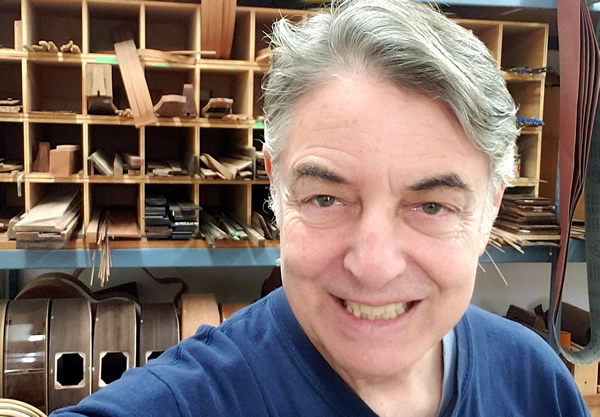About
First Impressions…
The first time I saw someone playing modern fingerstyle music with an acoustic steel string guitar was Michael Hedges at the Bottom Line in New York City in 1988. I had heard his recordings but up until then I really had no idea what he was actually doing on the guitar. I think that was a pivotal moment in my guitar building career. Even though I hadn’t built a guitar yet, that concert, those sounds and what Michael Hedges was doing on the guitar was permanently etched in my mind.

Taking The Plunge…
Fast forward to 1992. I’m back in Toronto looking for a job but I’m not really interested in any of the work I’m being offered. I had heard that there were people making their living by building custom guitars by hand and that sounded pretty interesting. In that age before the internet I don’t recall how I found out about a guitar building school called Timeless Instruments located in a small town in central Saskatchewan but it wasn’t too long after that until I got in my car and drove for three days to get there. Seven weeks later I had a completed guitar and I thought I knew everything there was to know!
My Shops…
After taking the course I found a local cabinet maker who rented me a space in his shop. That was actually a very good learning experience because an old world craftsman from Portugal named Manuel taught me how to safely and confidently use the larger machine tools with which I had no prior experience.
After a year I moved my little shop into the basement of my house. Back then there were no boutique guitar shows to go to. The famed Healdsburg Guitar Show was only just getting started. To sell the guitars I had made I went to the vintage guitar show in Michigan twice a year – The Michigan State Guitar Swap and Sale at the Michigan State Fairgrounds.
In my basement shop I could build 2 guitars every 6 months. Just in time to take them to Michigan. That was quite a successful show for me and I made a lot of good friends and customers there.
After about 5 years I moved my shop into the front half of an industrial unit which gave me more space. In 2001 I bought a house on 10 acres north of Toronto and constructed an 1800 square foot climate-controlled guitar building shop on the property. I’ve been building guitars there ever since.
Influences…
When I started in 1992 there were no apprenticeships being offered by anyone anywhere. I had found out pretty quickly after the guitar building course that I did not, in fact, know everything so I sought out the help of other guitarmakers. Although this was probably a slower process, it has allowed me to incorporate influences and ideas of many different guitarmakers, all of which have filtered down into my building in some form or another. Early on I received help from Grit Laskin and Linda Manzer. In 1994 I took Grit Laskin’s inlay course. At an Association of Stringed Instrument Artisans show in Easton PA I met Kent Everett from Atlanta who invited me to spend a weekend with him in his shop. After attending a presentation by Jim Olson at another show, I introduced myself and asked him some questions. He was very forthcoming with answers, even showing me photos of his guitar bracing and more. A few years later I got to spend an afternoon with him at his shop where he patiently answered even more questions! Over the years Charles Fox has become a good friend and I took his Small Shop Production Course in 2010, a real eye opener. I’ve had both Al Carruth and Bob Benedetto show me how they tap their guitar bodies and tell me what they listen for, which was amazing. I’ve also been lucky enough to tour the Martin Factory twice and get private tours of the Taylor and Santa Cruz factories.

The Evolution Of Design…
When you start building guitars, you “follow the recipe” as we like to say. Over time some people stick with the recipe, refining it to their liking while other builders use the recipe as a starting point and deviate from traditional approaches and designs as a way to suit their particular tastes. Both approaches are equally viable and have a place in the market. When I felt I was ready, I chose to deviate from the recipe. I not only had that Michael Hedges concert in my head but after I had been building for a few years I attended a concert where the performer played an unamplified Smallman guitar in a church. It was remarkable. At the time there was no information available about exactly what Smallman was doing so I began working on that using a method I call Imaginary Reverse Engineering. I was also being guided and continue to be guided by some excellent players. Incorporating their ideas and suggestions into my designs is always ongoing. Ultimately the models you see on this website are the result of this effort to continually improve. It’s been a great journey of learning and discovery for me.
The process still continues every day…
